
The flag of the United States goes by different names — The Stars and Stripes; The Red, White, and Blue; Old Glory; and The Star-Spangled Banner. Regardless of what it is called, the American flag is one of the most recognizable symbols of any country in the world, and the inspiration for our national anthem. This is the history behind each of America’s national anthems, songs, and marches.
The first official national flag was approved by the Continental Congress on June 14, 1777. The resolution read: “Resolved, that the flag of the United States be thirteen stripes, alternate red and white; that the union be thirteen stars, white in a blue field representing a new constellation.” Each star represented a state and each stripe represented the 13 colonies that declared independence from Great Britain. The colors of the flag were inherited from British flags and have no official meaning.
Since the founding of the United States in 1776, there have been 27 different versions of the flag featuring the stars and stripes. Each new flag represented the addition of one or more states as the United States grew westward to fulfill what it believed to be its manifest destiny of expansion in North America.
As Independence Day nears, 24/7 Wall St. is taking a look at how each of these 27 flags got that way. We reviewed sites such as usflagdepot.com and various history websites to find out how each state was added to the Union, thus affixing a new star to the flag.
Of the 27 versions of the United States flag, nine flew for only about a year, reflecting the rapid expansion of the nation. Though we have not had a new star since 1960 — Hawaii — we may not be done adding stars. American-owned. territories Puerto Rico, American Samoa, Guam, the Northern Mariana Islands, and the U.S. Virgin Islands, might be considered for statehood.
Click here to see the 27 different U.S. flags and how they got that way
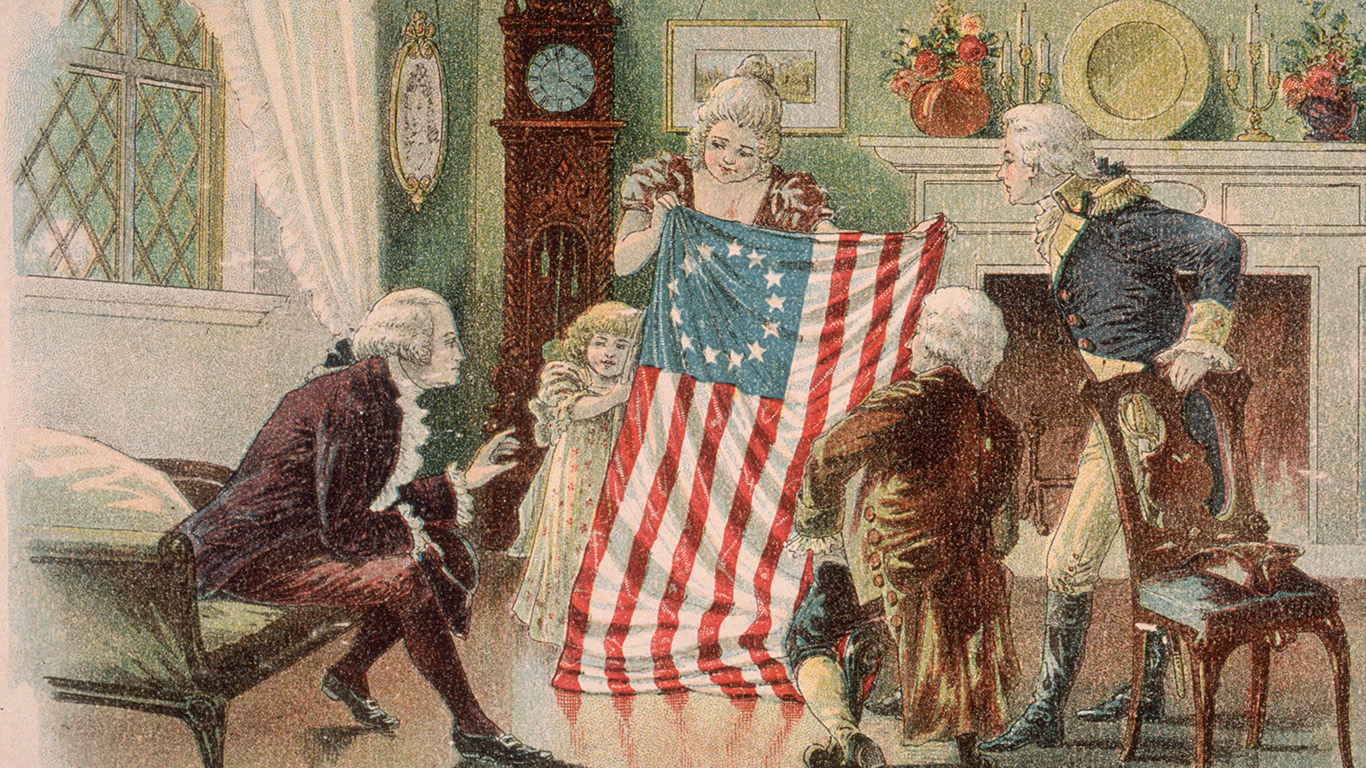
1. Thirteen-Star U.S. Flag
> Years flown: 1777 ~ 1795
> Who was president: George Washington (1789-1797)
The 13-star flag officially became the U.S. flag on June 14, 1777, and the date is celebrated every year in the United States as Flag Day. Though there is no conclusive proof, Francis Hopkinson, a congressman from New Jersey and a signer of the Declaration of Independence, is credited with designing the flag. Each star and stripe represented a former British colony.
[in-text-ad]
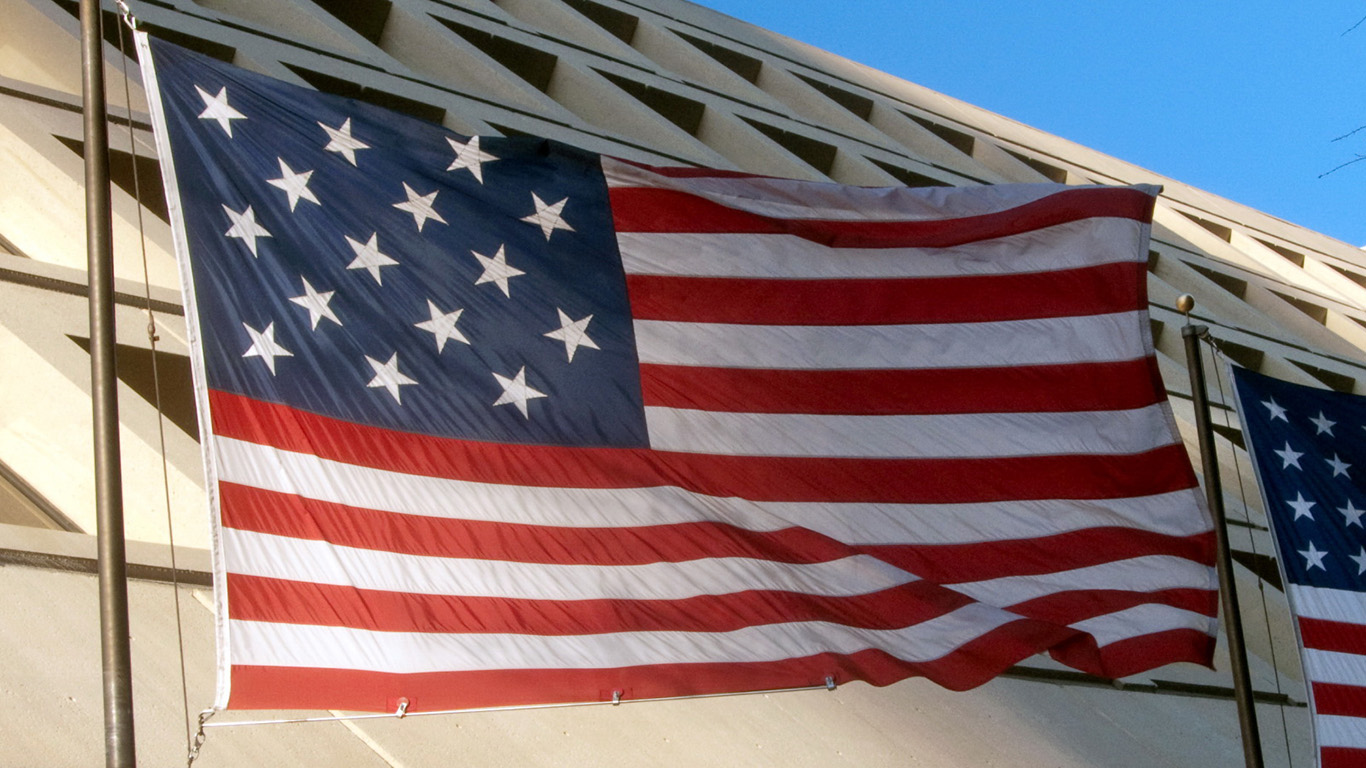
2. Fifteen-Star U.S. Flag
> Years flown: 1795 ~ 1818
> Who was president: George Washington (1789-1797), John Adams (1797-1801), Thomas Jefferson (1801-1809), James Madison (1809-1817), and James Monroe (1817-1825)
Two stripes and two stars were added to the flag when Vermont and Kentucky became the 14th and 15th states in 1791 and 1792, respectively. The 15-star flag would last for 23 years and five presidents would serve under it. This flag inspired Francis Scott Key to write “The Star Spangled Banner,” our national anthem, after Key saw the flag continue to fly over Fort McHenry following a British bombardment during the War of 1812.
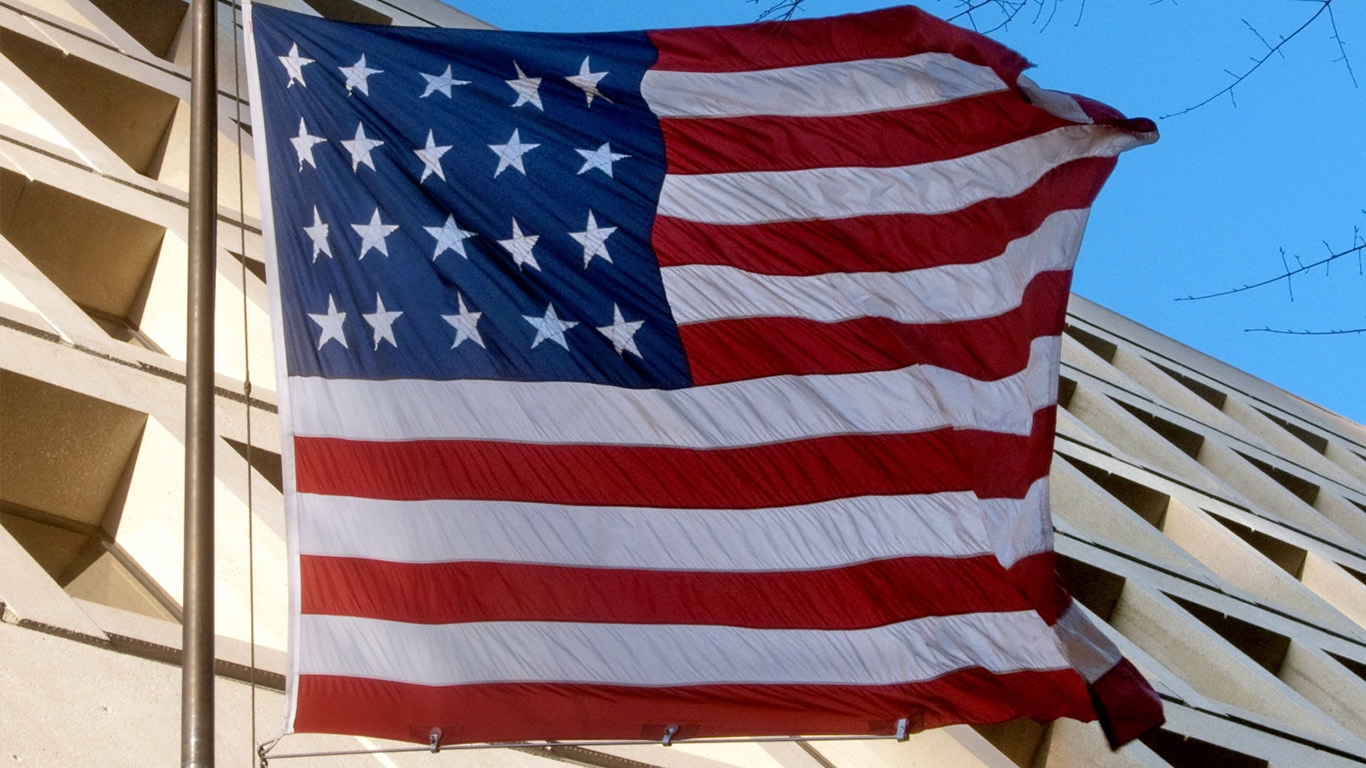
3. Twenty-Star U.S. Flag
> Years flown: 1818 ~ 1819
> Who was president: James Monroe (1817-1825)
With the westward expansion of the United States and the addition of more states, Congress realized that adding stripes to the flag would be impractical. So Congress passed the Flag Act in 1818, restoring the original 13-stripe design and unveiling the flag with additional stars on July 4. Five stars were added to represent five new states: Tennessee (1796), Ohio (1803), Louisiana (1812), Indiana (1816), and Mississippi (1817). The 20-star flag became the official flag on April 13, 1818, and it was the first of nine flags to only last about a year.

4. Twenty-One Star U.S. Flag
> Years flown: 1819 ~ 1820
> Who was president: James Monroe (1817-1825)
Just over a year after the twenty-star flag was introduced, the United States added Illinois to the Union, boosting the number of states to 21. Illinois, where future president Abraham Lincoln began his political career, was admitted on Dec. 3, 1818.
[in-text-ad-2]

5. Twenty-Three Star U.S. Flag
> Years flown: 1820 ~ 1822
> Who was president: James Monroe (1817-1825)
The number of U.S. states rose to 23 with the admission of Alabama in 1819 and Maine in 1820. The flag became the official U.S. flag on July 4, 1820, and would last two years. President James Monroe was the only president to serve under this flag as well as the previous two flags.
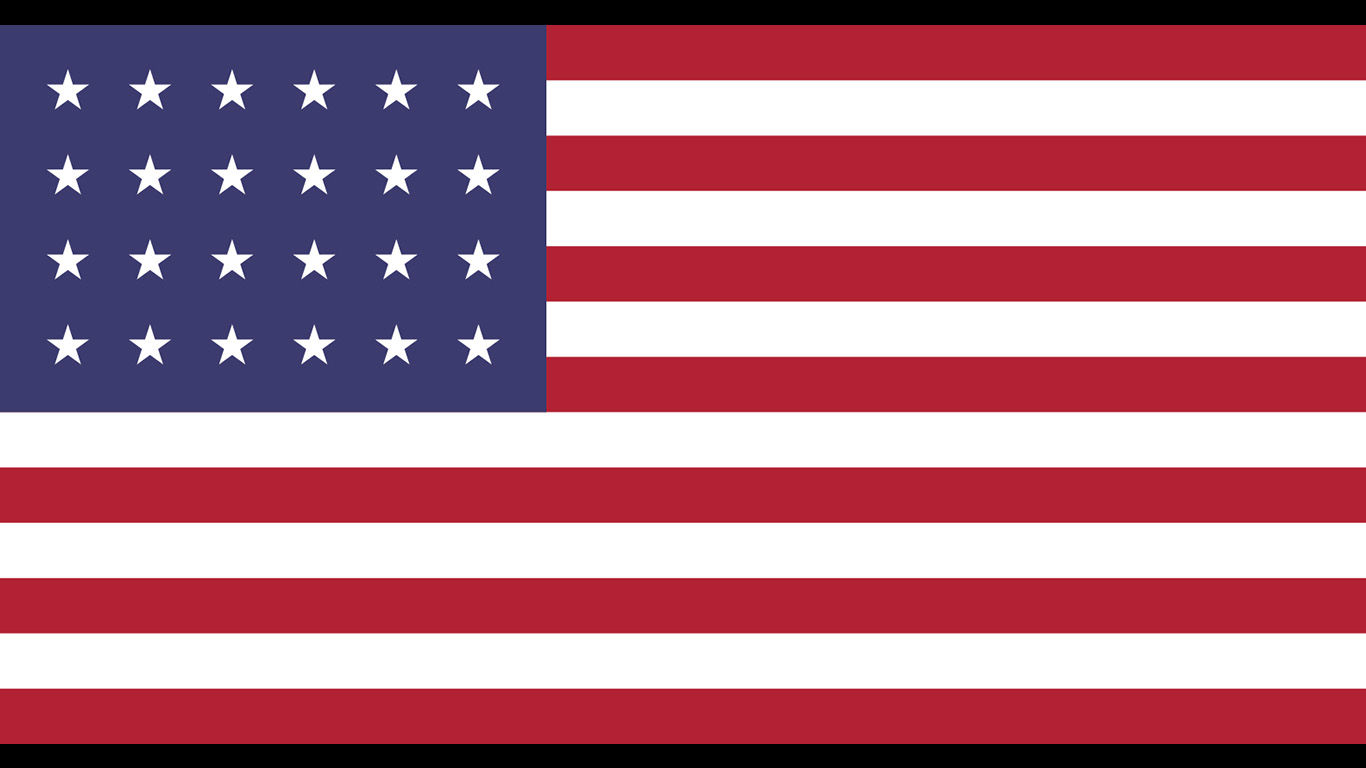
6. Twenty-Four Star U.S. Flag
> Years flown: 1822 ~ 1836
> Who was president: James Monroe (1817-1825), John Quincy Adams (1825-1829), and Andrew Jackson (1829-1837)
The flag expanded to 24 stars with the addition of Missouri in 1821. Missouri, a slave state, was admitted as part of the Missouri Compromise, which sought to achieve a balance of free and slave states during the antebellum period. The compromise included the admission of Maine, a free state, which had separated from Massachusetts and become a state the previous year.
[in-text-ad]

7. Twenty-Five Star U.S. Flag
> Years flown: 1836 ~ 1837
> Who was president: Andrew Jackson (1829-1837) and Martin Van Buren (1837-1841)
Arkansas joined the Union as a slave state on June 15, 1836. Less than a month later, its star was included in the U.S. flag, pushing the state total to 25. Arkansas was part of the Louisiana Purchase and carved out of what became the Missouri Territory to become its own territory.

8. Twenty-Six Star U.S. Flag
> Years flown: 1837 ~ 1845
> Who was president: Martin Van Buren (1837-1841), William Henry Harrison (1841), John Tyler (1841-1845), and James Polk (1845-1849)
Michigan was admitted to the Union in 1837 as a free state to help maintain the balance between slave and free states. Michigan’s admission had been thwarted because of a border dispute with Ohio — which had been admitted as a state in 1803 — but President Andrew Jackson helped Michigan save face by awarding it land from the Upper Peninsula, and then it was granted statehood, boosting the number of states to 26.
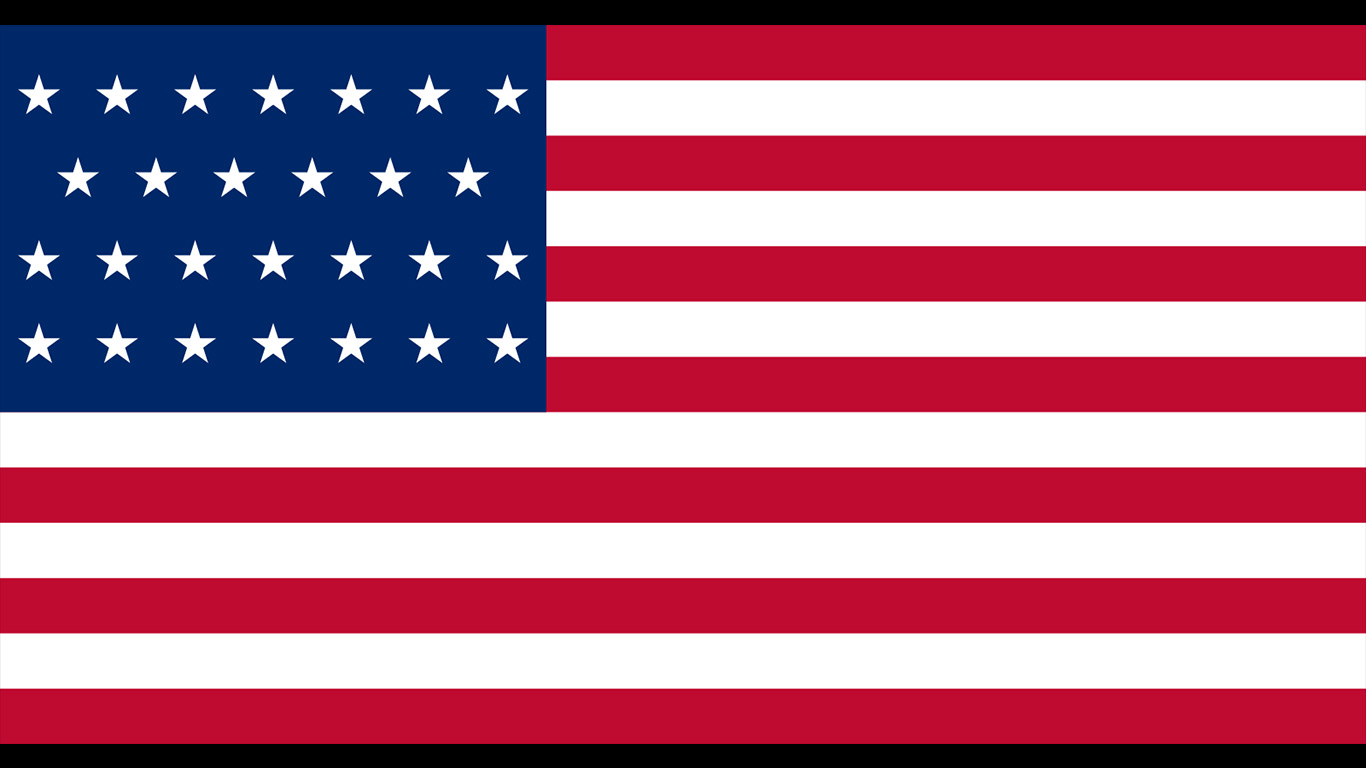
9. Twenty-Seven Star U.S. Flag
> Years flown: 1845 ~ 1846
> Who was president: James Polk (1845-1849)
Florida, a former possession of the Spanish empire, was admitted to the Union in 1845, raising the total number of U.S. states to 27. It would not remain in the Union for long: Florida would secede in 1861.
[in-text-ad-2]
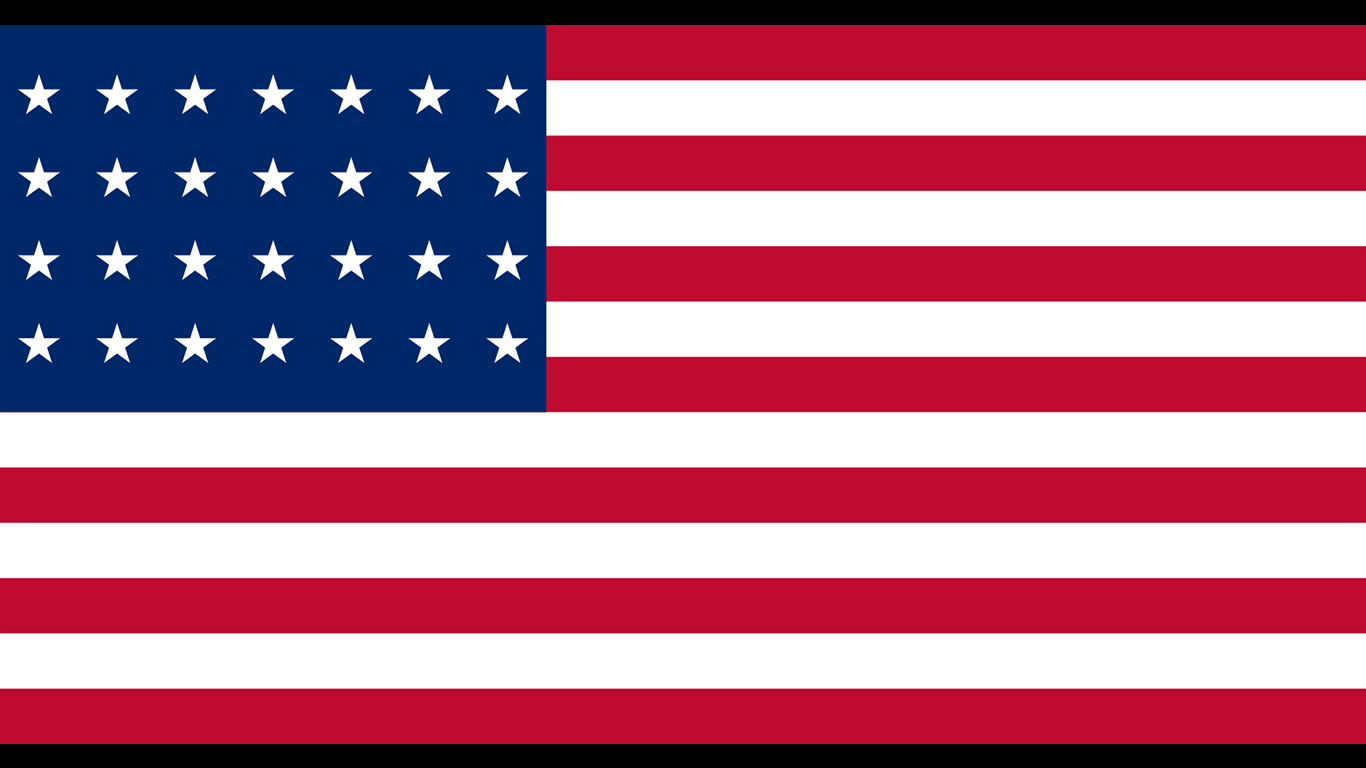
10. Twenty-Eight Star U.S. Flag
> Years flown: 1846 ~ 1847
> Who was president: James Polk (1845-1849)
In 1846, the flag would undergo another change, this time because of the admission of Texas. Before becoming the 28th state, the Lone Star state had broken away from Mexico in 1836. It was an independent republic before joining the Union and becoming the biggest state in land mass in the contiguous 48 states.
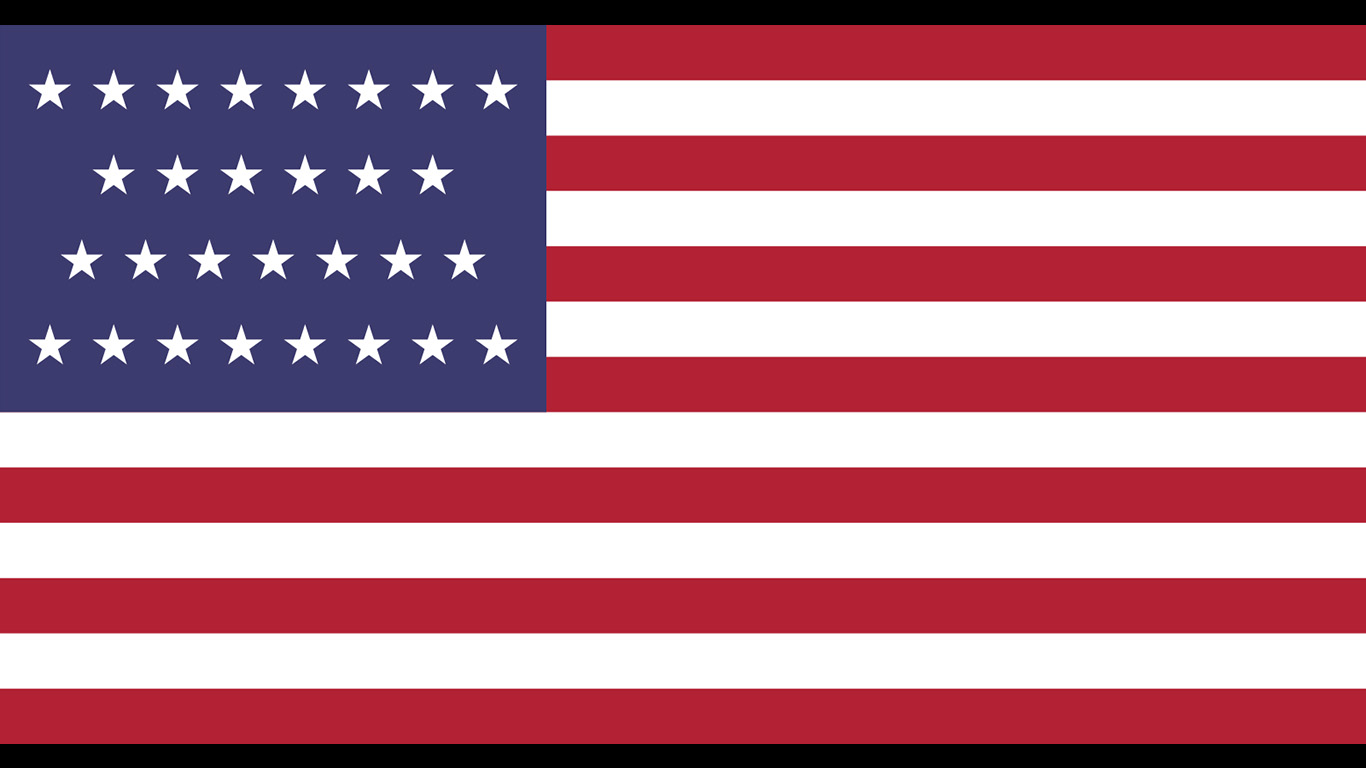
11. Twenty-Nine Star U.S. Flag
> Years flown: 1847 ~ 1848
> Who was president: James Polk (1845-1849)
Iowa was admitted to the Union on Dec. 28, 1846, as a free state to maintain the balance between free and slave states during the antebellum period. Its star was added to the U.S. flag the following July 4. Originally part of the Louisiana Purchase, Iowa grew dramatically because of its rich farmland. Iowa had been established as a U.S. territory in 1838.
[in-text-ad]
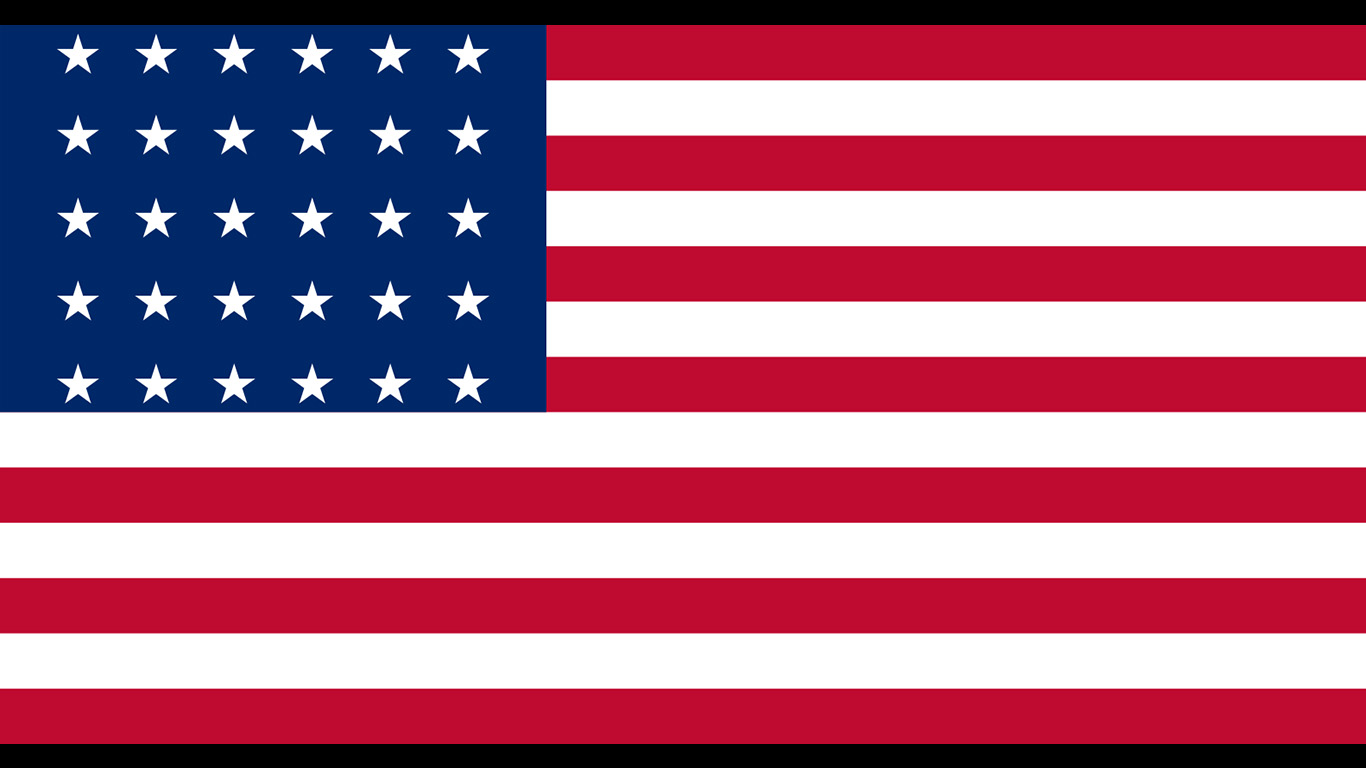
12. Thirty-Star U.S. Flag
> Years flown: 1848 ~ 1851
> Who was president: James Polk (1845-1849), Zachary Taylor (1849-1850),and Millard Fillmore (1850-1853)
Wisconsin became a state on May 29, 1848, adding the 30th star to the U.S. flag less than two months later. Not all residents of Wisconsin were enthusiastic about statehood. They had rejected it four times previously because they were concerned statehood would mean higher taxes.
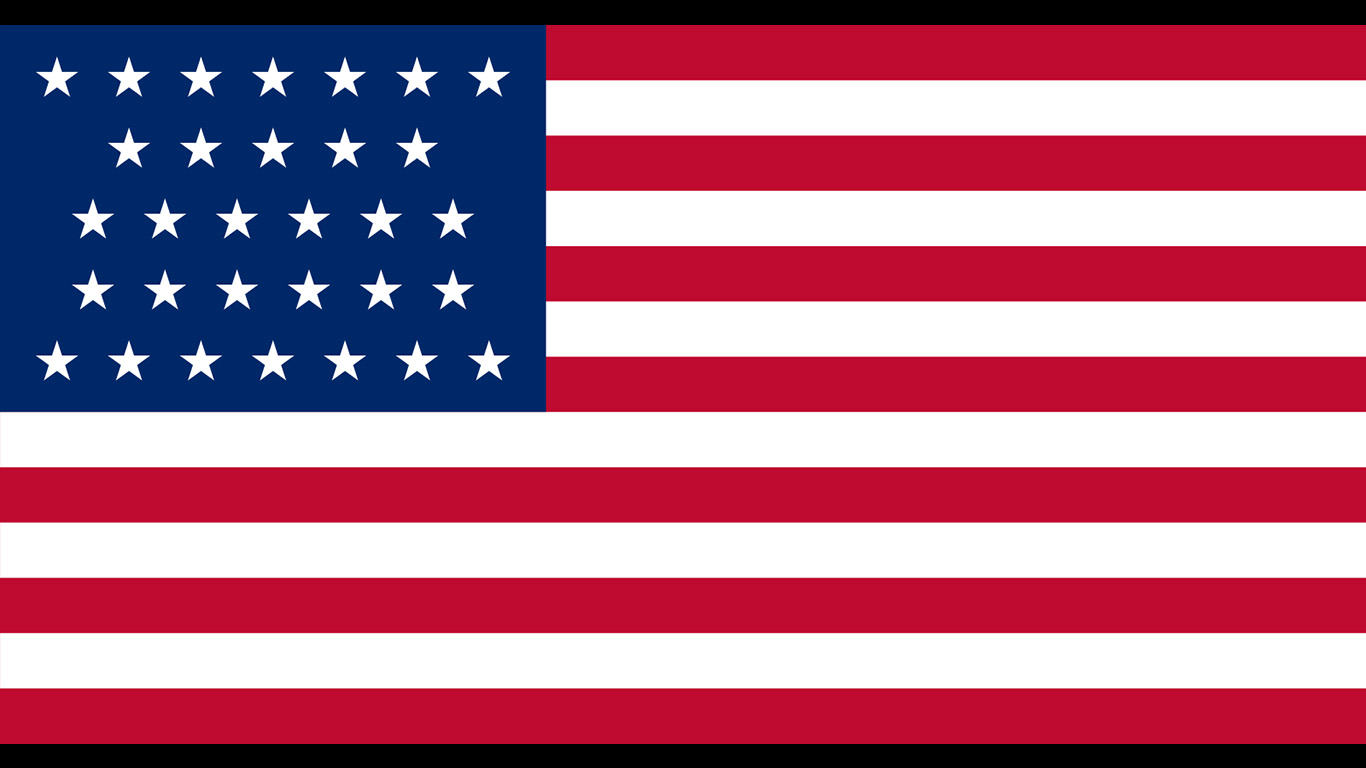
13. Thirty-One Star U.S. Flag
> Years flown: 1851 ~ 1858
> Who was president: Millard Fillmore (1850-1853), Franklin Pierce (1853-1857), and James Buchanan (1857-1861)
The Gold Rush that began with the discovery of the precious metal in 1848 helped fast-track California to statehood in 1850. California became the 31st star on the American flag the following July 4. The admission of California fulfilled America’s manifest destiny of a nation extending from sea to sea.

14. Thirty-Two Star U.S. Flag
> Years flown: 1858 ~ 1859
> Who was president: James Buchanan (1857-1861)
On the eve of the Civil War, Minnesota was admitted to the Union on May 11, 1858, and represented as the 32nd state on the flag less than two months later. Minnesota was admitted as a free state.
[in-text-ad-2]
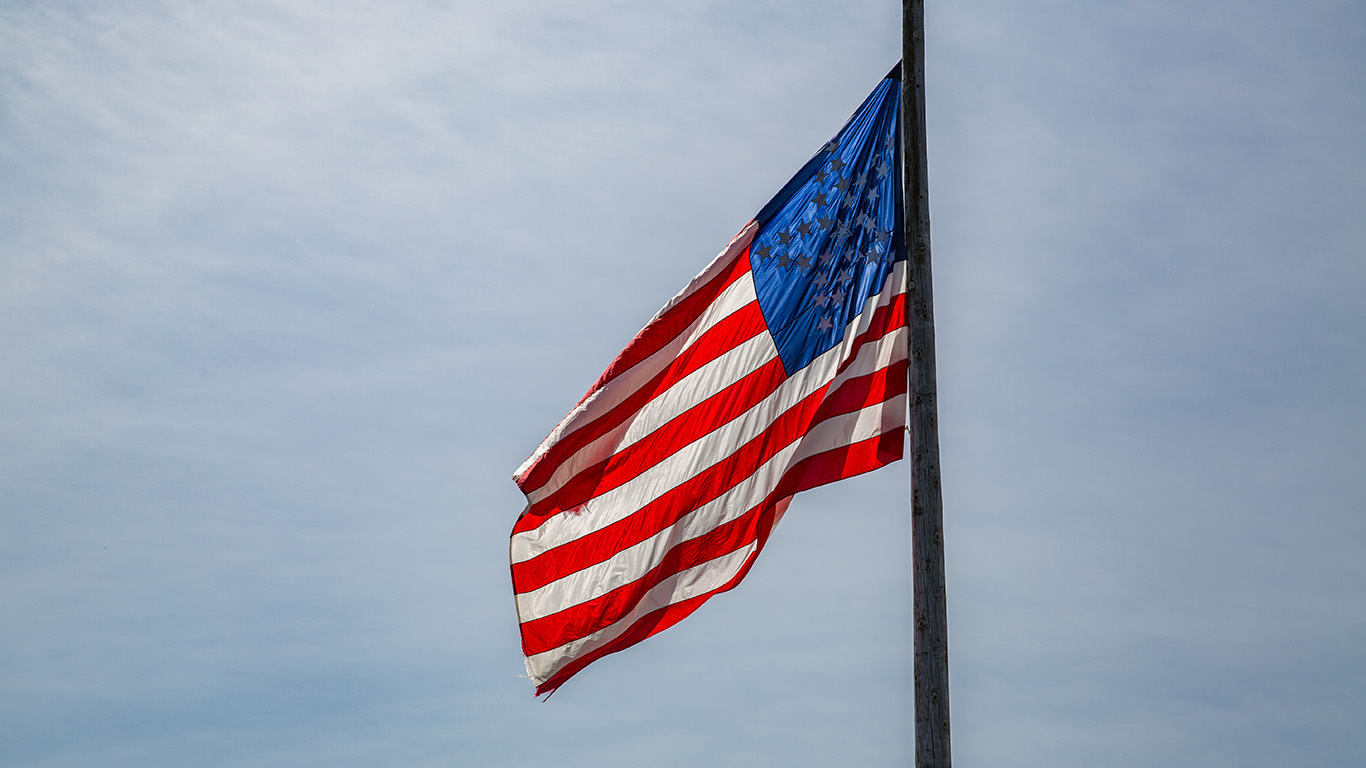
15. Thirty-Three Star U.S. Flag
> Years flown: 1859 ~ 1861
> Who was president: James Buchanan (1857-1861) and Abraham Lincoln (1861-1865)
America’s expansion surged to the Northwest with the admission of Oregon on Feb. 14, 1859, adding a 33rd star to the flag the following July. Oregon, which had become a U.S. territory in 1848, was admitted as a free state, though its first two senators, Joseph Lane and Delazon Smith, were proslavery Democrats.

16. Thirty-Four Star U.S. Flag
> Years flown: 1861 ~ 1863
> Who was president: Abraham Lincoln (1861-1865)
Kansas became the 34th state to join the Union. Voter fraud over whether the state would be admitted as a slave state or a free state delayed its admission. Kansas joined the Union on Jan. 29, 1861 as a free state, just as the southern states were seceding, and its star was represented on the flag six months later.
[in-text-ad]

17. Thirty-Five Star U.S. Flag
> Years flown: 1863 ~ 1865
> Who was president: Abraham Lincoln (1861-1865) and Andrew Johnson (1865-1869)
The onset of the Civil War did not halt the admission of states to the Union. The western part of Virginia was pro-Union and contained many abolitionists. It split from the rest of the state, which had seceded. President Abraham Lincoln was unsure about dividing Virginia and admitting the western portion as a separate state. He agreed to its admission on the grounds that West Virginia’s action was an act of secession in favor of the Constitution. West Virginia joined the Union on June 20, 1863, and a new flag on July 4 included the 35th state.
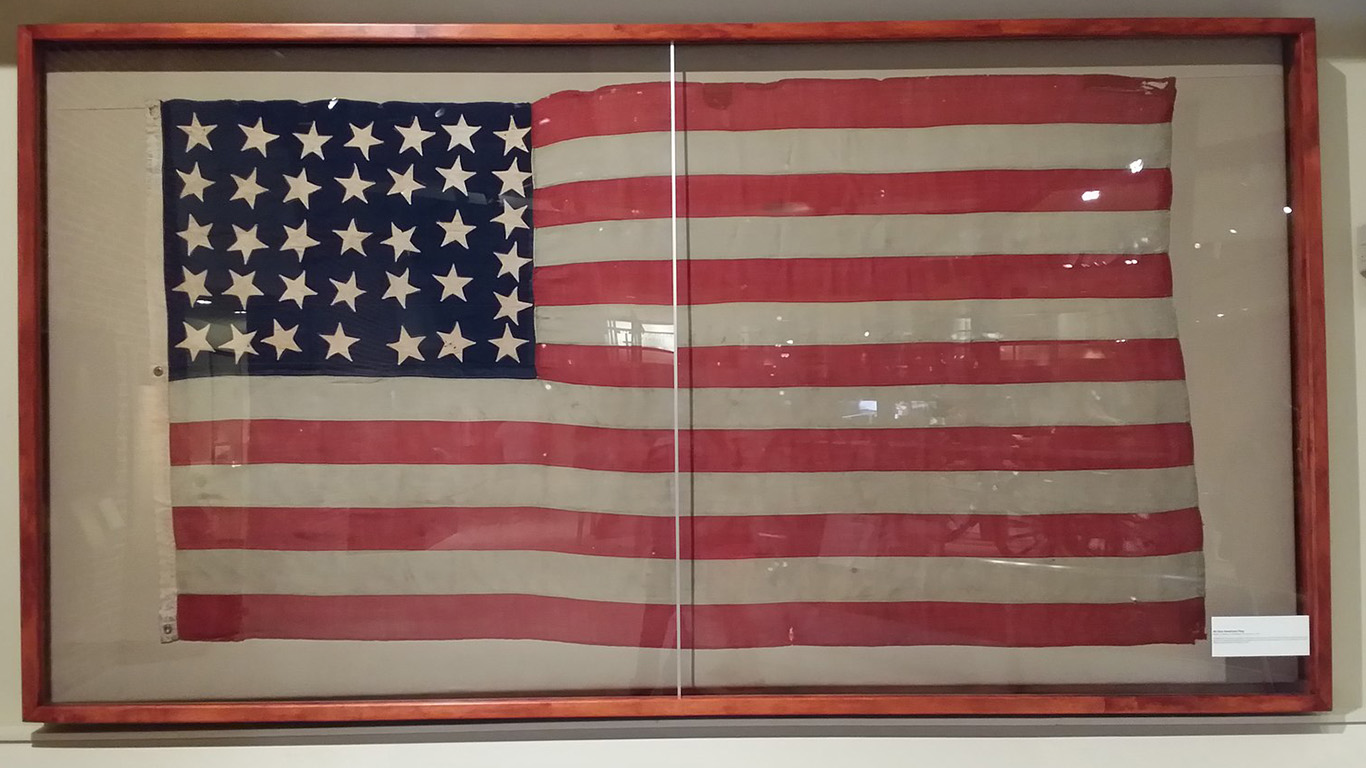
18. Thirty-Six Star U.S. Flag
> Years flown: 1865 ~ 1867
> Who was president: Andrew Johnson (1865-1869)
The Civil War was engulfing the nation when Nevada was admitted as the 36th state on Oct. 31, 1864, and the 36th star on the U.S. flag the following July. Nevada was pro-Union and President Abraham Lincoln saw Nevada’s admission as a way to buttress support for the war. To speed up statehood, Nevada sent its entire state constitution to Washington, D.C. — 175 pages — by telegram.
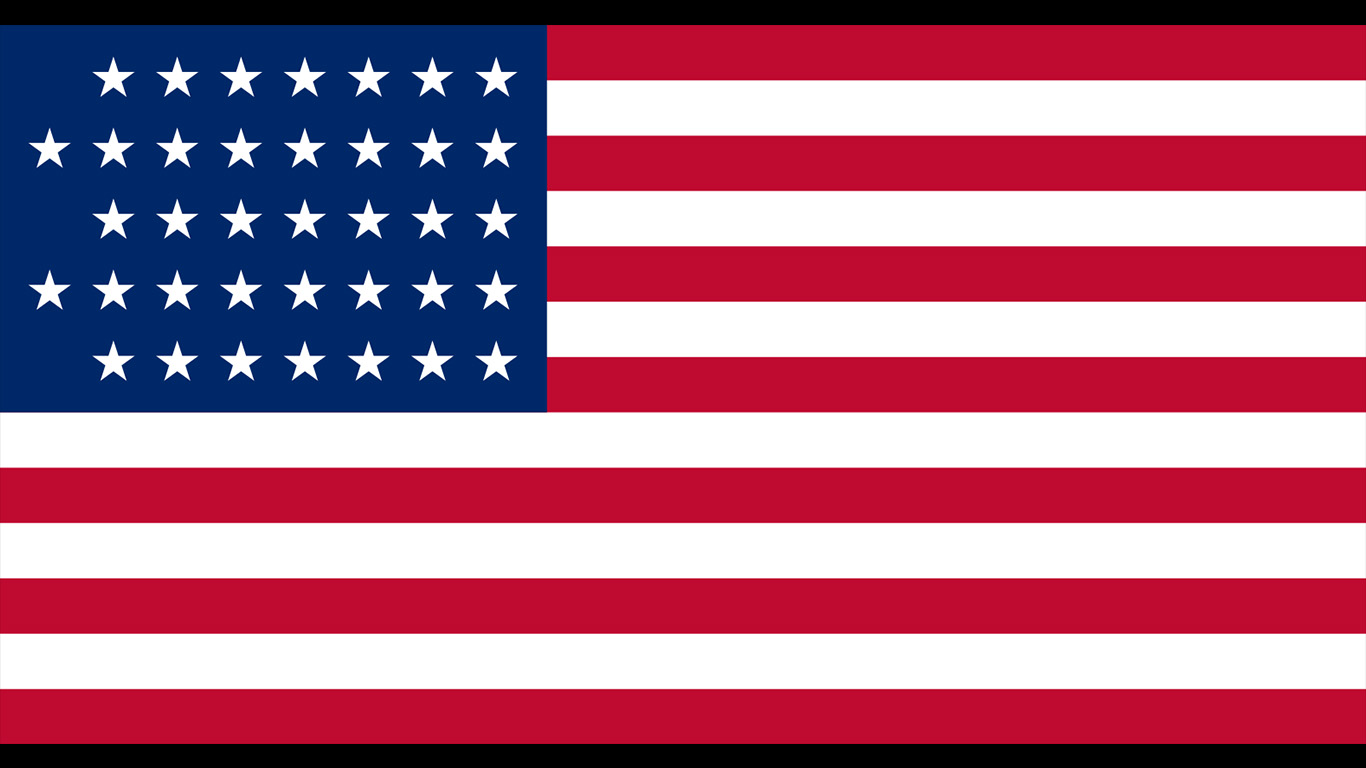
19. Thirty-Seven Star U.S. Flag
> Years flown: 1867 ~ 1877
> Who was president: Andrew Johnson (1865-1869), Ulysses S. Grant (1869-1877), and Rutherford B. Hayes (1877-1881)
Nebraska was the first state to be admitted to the Union after the Civil War. After the Civil War, rapid economic development accelerated by the growth of railroads helped speed Nebraska’s admission to the Union on March 1, 1867, becoming the nation’s 37th state and the 37th star on the flag.
[in-text-ad-2]

20. Thirty-Eight Star U.S. Flag
> Years flown: 1877 ~ 1890
> Who was president: Rutherford B. Hayes (1877-1881), James A. Garfield (1881), Chester A. Arthur (1881-1885), Grover Cleveland (1885-1889), and Benjamin Harrison (1889-1893)
Colorado, a territory that partially came with the Louisiana Purchase in 1803, became the 38th state to join the Union on Aug. 1, 1876. Colorado’s admission had been vetoed by President Andrew Johnson, but President Ulysses S. Grant approved it. The 38-star flag would fly for 13 years.
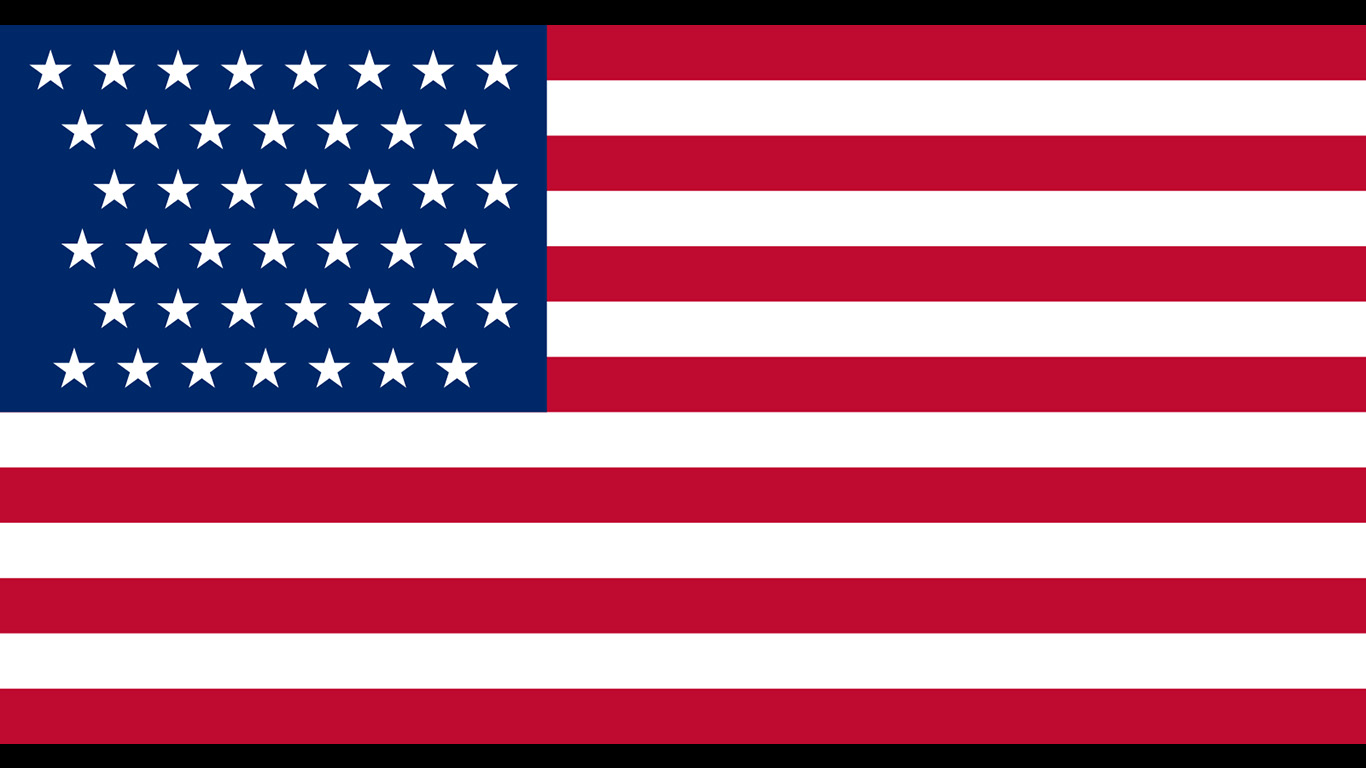
21. Forty-Three Star U.S. Flag
> Years flown: 1890 ~ 1891
> Who was president: Benjamin Harrison (1889-1893)
A flurry of state admissions boosted the star total on the flag to 43 by July 4, 1890, as statehood filled out the United States in the high plains and the far west. Five states were admitted to the Union and five stars added to the flag: North Dakota, South Dakota, Montana, and Washington all in 1889, and Idaho in 1890.
[in-text-ad]

22. Forty-Four Star U.S. Flag
> Years flown: 1891 ~ 1896
> Who was president: Benjamin Harrison (1889-1893) and Grover Cleveland (1893-1897)
Six states were admitted to the Union when President Benjamin Harrison was president, more than any other president. Wyoming was the last of the six, boosting the number of stars on the flag to 44. Wyoming was admitted on July 10, 1890, even though it was 5,000-people short of the 60,000-person requirement to become a state.

23. Forty-Five Star U.S. Flag
> Years flown: 1896 ~ 1908
> Who was president: Grover Cleveland (1893-1897), William McKinley (1897-1901), and Theodore Roosevelt (1901-1909)
Utah became a state on Jan. 4, 1896, and the 45th star on the flag later that year. However, the area that would become Utah had been part of the United States since the nation received the territory as part of a treaty that ended the Mexican-American War in 1848. Mormons settled in the area, and their practice of polygamy prevented Utah from becoming a state until Mormons renounced polygamy in the state constitution.

24. Forty-Six Star U.S. Flag
> Years flown: 1908 ~ 1912
> Who was president: Theodore Roosevelt (1901-1909) and William H. Taft (1909-1913)
Oklahoma became the first state to be admitted to the Union in the 20th century, on Nov. 16, 1907, taking its place on the U.S. flag as the 46th star the following year. The United States had used the Oklahoma territory to resettle Native American people, but by the late 19th century, Texas ranchers began moving northward and the federal government decided to open up the territory for homesteaders.
[in-text-ad-2]
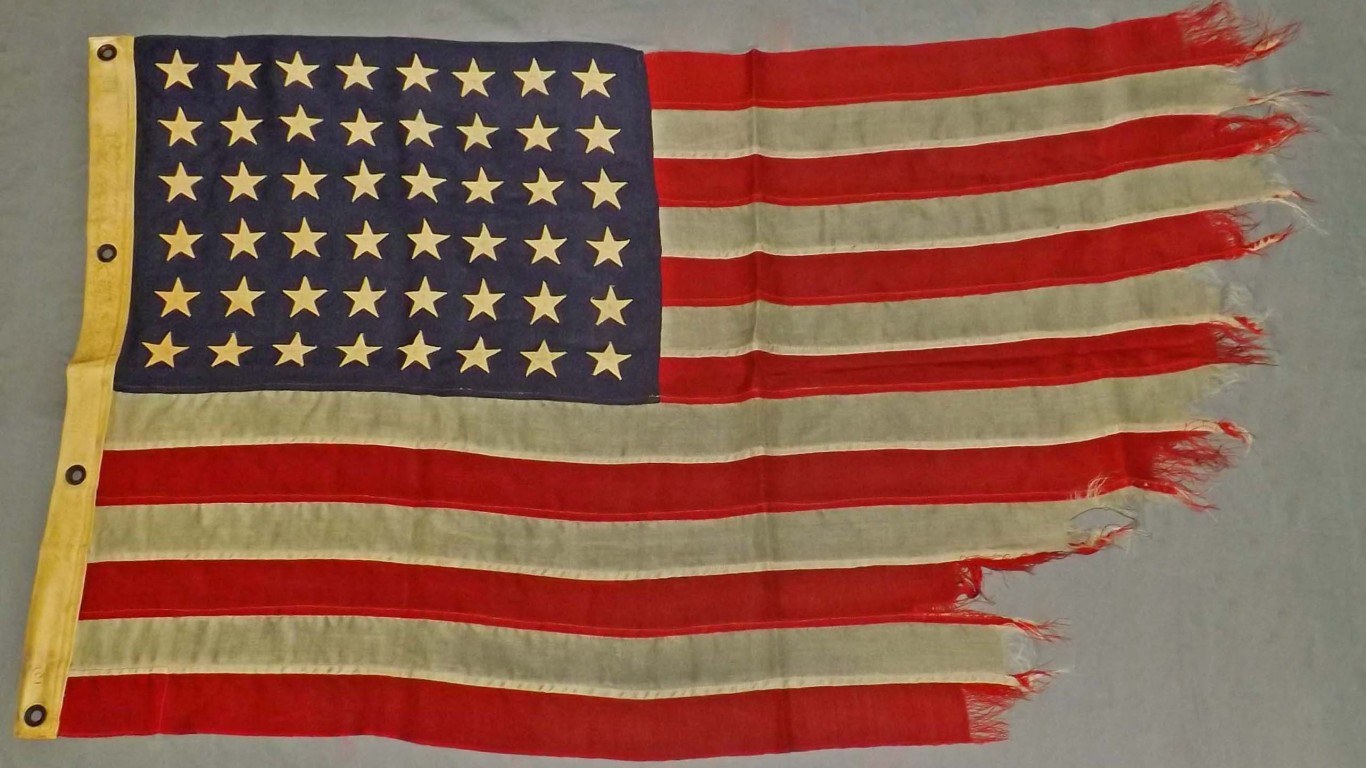
25. Forty-Eight Star U.S. Flag
> Years flown: 1912 ~ 1959
> Who was president: William H. Taft (1909-1913), Woodrow Wilson (1913-1921), Warren Harding (1921-1923), Calvin Coolidge (1923-1929), Herbert Hoover (1929-1933), Franklin D. Roosevelt (1933-1945), Harry S.Truman (1945-1953), Dwight D. Eisenhower (1953-1961)
The southwestern territories of New Mexico and Arizona were the last to join the 48 contiguous states. New Mexico became the 47th state on Jan. 6, 1912, and Arizona attained statehood on Feb. 14, 1912. The 48-star flag flew longer than any other flag before it, 47 years, and eight presidents served under it.
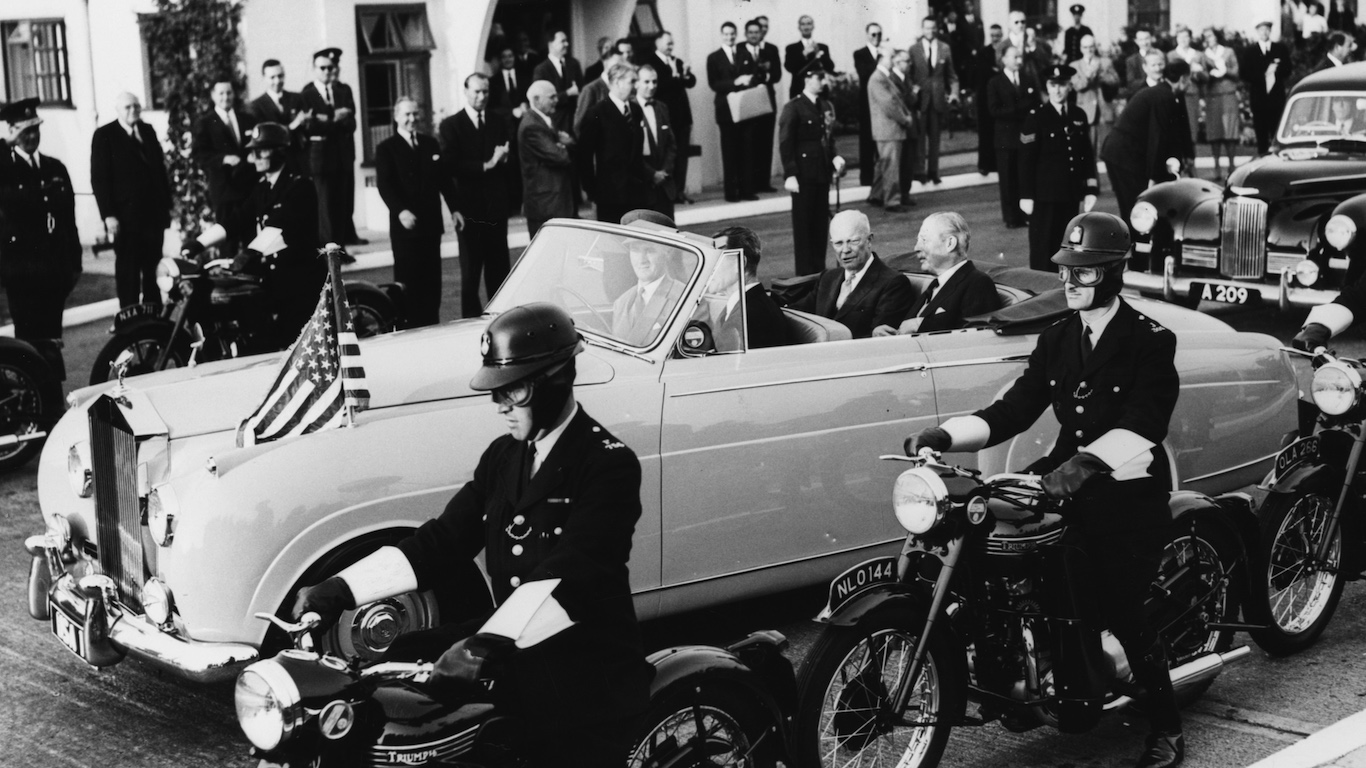
26. Forty-Nine Star U.S. Flag
> Years flown: 1959 ~ 1960
> Who was president: President Eisenhower (1953-1961)
Alaska became the first non-contiguous territory to become a state on Jan. 3, 1959, and the 49th star on the U.S. flag. Alaska, which was purchased from Russia in 1867, is 2.5 times the size of Texas, the second-largest U.S. state. The 49-star flag was the last of the nine flags to fly for just one year.
[in-text-ad]
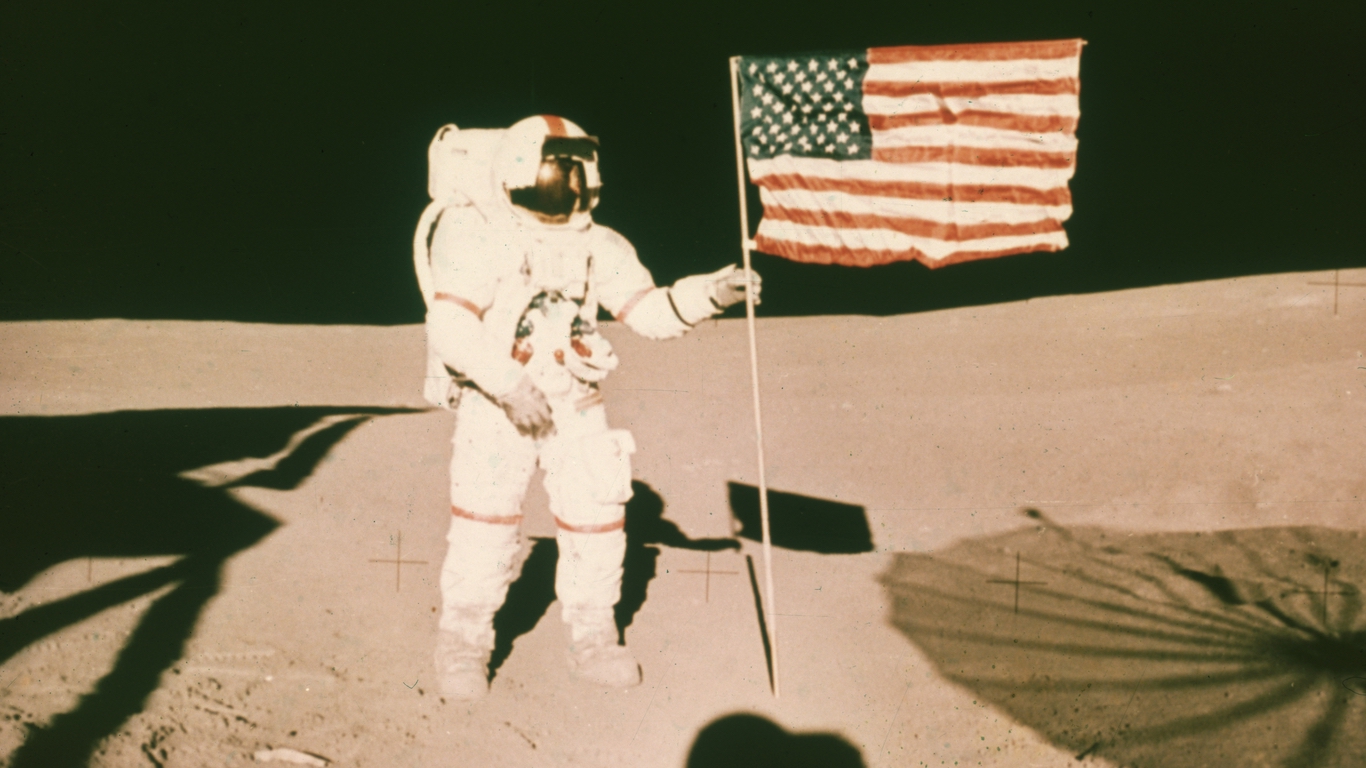
27. Fifty-Star U.S. Flag
> Years flown: 1960 ~ present
> Who was president: Presidents Eisenhower (1953-1961), John F. Kennedy (1961-1963), Lyndon B. Johnson (1963-1969), Richard M. Nixon (1969-1974), Gerald R. Ford (1974-1977), Jimmy Carter (1977-1981), Ronald Reagan (1981-1989) George H.W. Bush (1989-1993), William Clinton (1993-2001), George W. Bush (2001-2009), Barack Obama (2009-2017), Donald Trump (2017-present)
Hawaii is the 50th state, and joined the Union on Aug. 21, 1959. The 50-star flag has flown the longest of any U.S. flag, and in July it will have flown for 59 years. Twelve presidents have served under this flag.
Are You Still Paying With a Debit Card?
The average American spends $17,274 on debit cards a year, and it’s a HUGE mistake. First, debit cards don’t have the same fraud protections as credit cards. Once your money is gone, it’s gone. But more importantly you can actually get something back from this spending every time you swipe.
Issuers are handing out wild bonuses right now. With some you can earn up to 5% back on every purchase. That’s like getting a 5% discount on everything you buy!
Our top pick is kind of hard to imagine. Not only does it pay up to 5% back, it also includes a $200 cash back reward in the first six months, a 0% intro APR, and…. $0 annual fee. It’s quite literally free money for any one that uses a card regularly. Click here to learn more!
Flywheel Publishing has partnered with CardRatings to provide coverage of credit card products. Flywheel Publishing and CardRatings may receive a commission from card issuers.
Thank you for reading! Have some feedback for us?
Contact the 24/7 Wall St. editorial team.
 24/7 Wall St.
24/7 Wall St.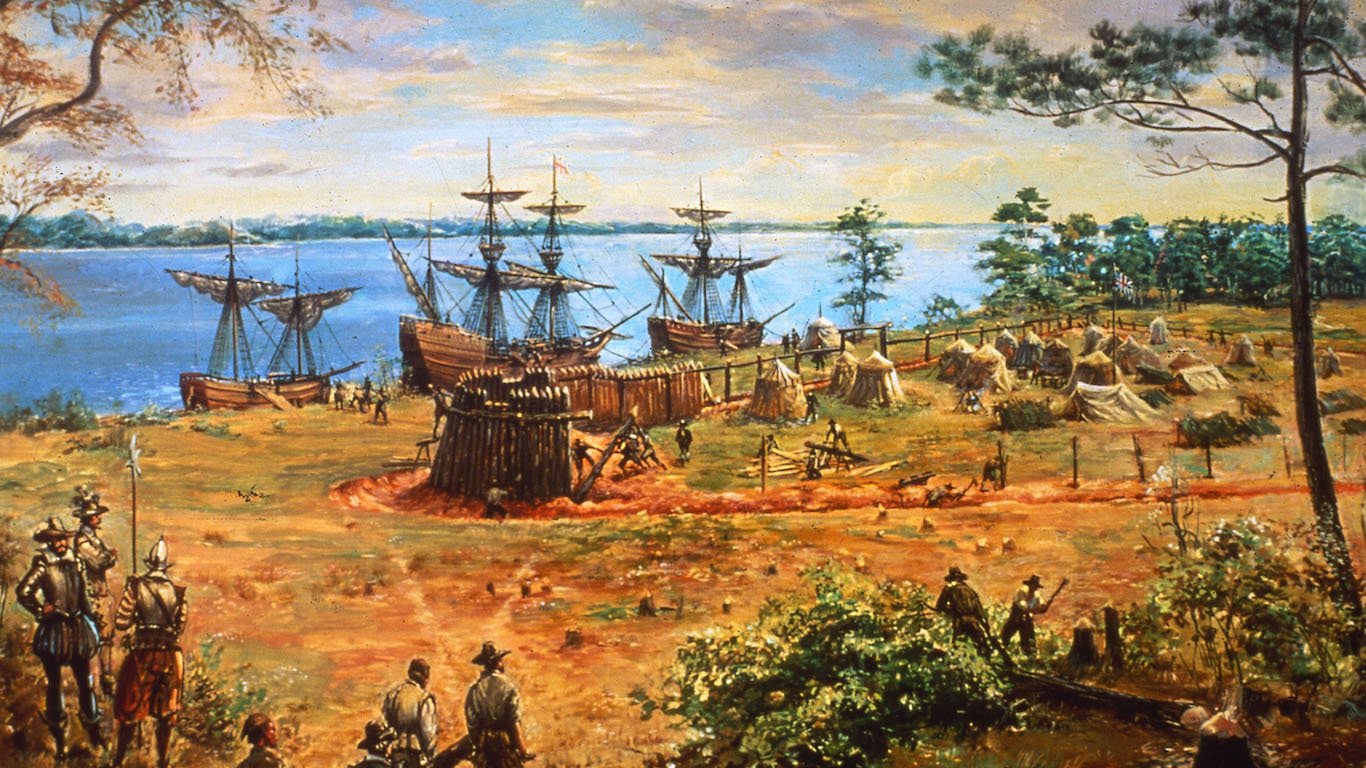 24/7 Wall St.
24/7 Wall St. 24/7 Wall St.
24/7 Wall St.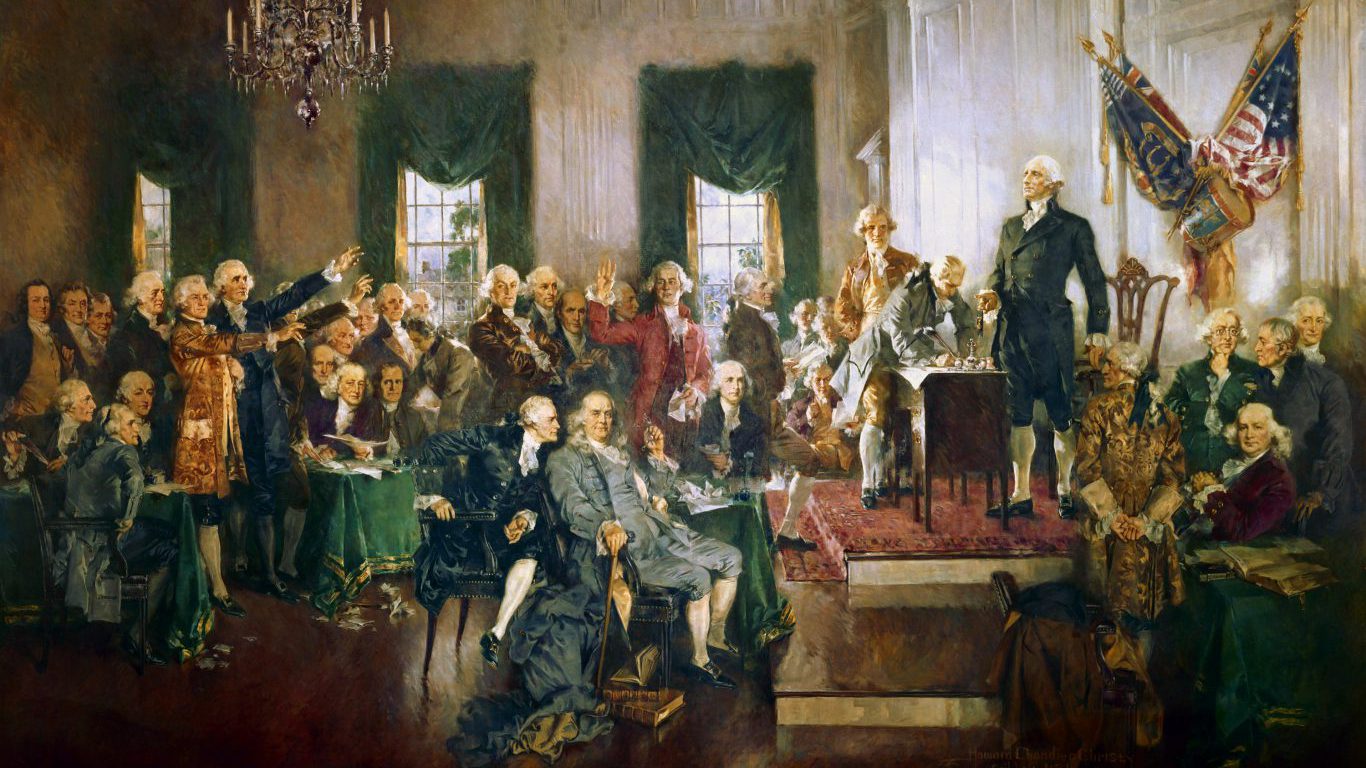 24/7 Wall St.
24/7 Wall St. 24/7 Wall St.
24/7 Wall St.